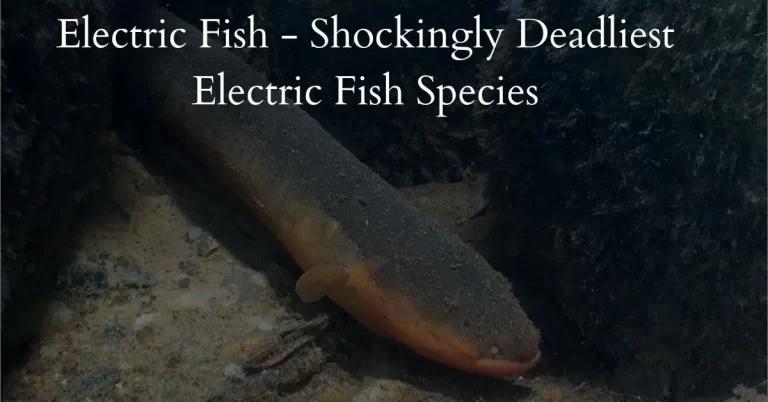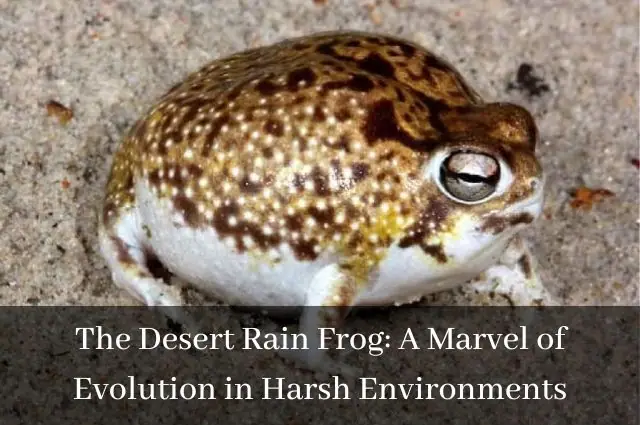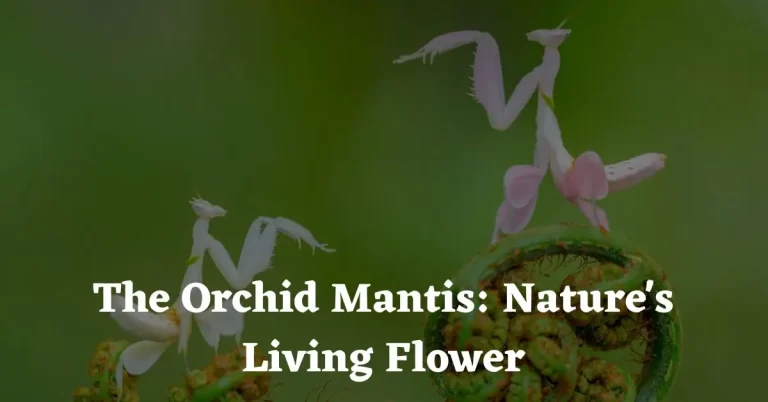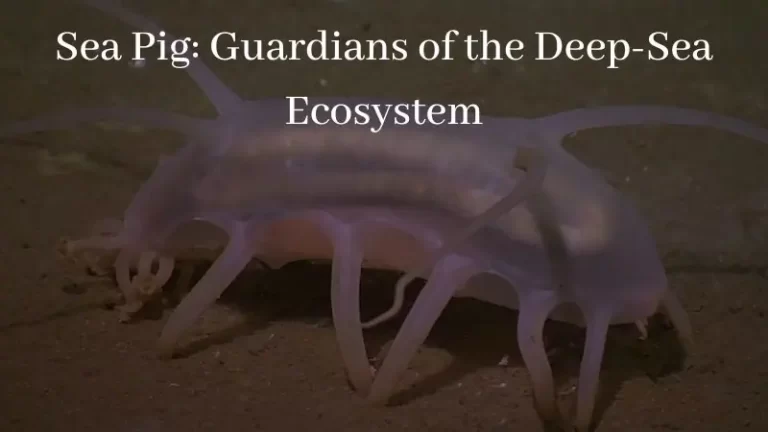The Devil’s Flower Mantis | Nature’s Master of Camouflage

The Devil’s Flower Mantis (Idolomantis diabolica) is a captivating mantis species found in the rainforests of Central and East Africa. With its vibrant colors and extraordinary camouflage abilities, it stands out among its insect counterparts. Growing up to 6 inches in length, the Devil’s Flower Mantis exhibits a unique physique, with females resembling flower petals and males boasting a streamlined appearance.
Devils Flower Mantis hunting technique mimics a flower to lure prey. Courtship rituals are elaborate, and the female lays her eggs in a frothy protective case. Despite its captivating allure, the Devil’s Flower Mantis faces conservation challenges due to habitat loss and the illegal pet trade, prompting efforts to protect this remarkable species.
All About Devil’s Flower Mantis
Scientific Classification
The scientific classification of the Devil’s Flower Mantis is as follows:
Scientific name: Idolomantis diabolica Kingdom: Animalia Phylum: Arthropoda Class: Insecta Order: Mantodea Family: Empusidae Genus: Idolomantis Species: Idolomantis diabolical
The Devil’s Flower Mantis belongs to the Mantodea order, which includes various species of praying mantises. It is classified within the Empusidae family, which consists of mantises known for their resemblance to flowers or twigs. The genus name of the Devil’s Flower Mantis is Idolomantis, and its species name is diabolica. “Diabolica” refers to its devil-like appearance and behavior.
.
Appearance
The Devil’s Flower Mantis exhibits a striking and captivating appearance, making it one of the most visually stunning mantis species. Its body is elongated and slender, reaching lengths of up to 6 inches (15 centimeters). The coloration of this mantis species is highly variable, ranging from vibrant shades of green to reddish-brown or even pinkish hues.
One of the most fascinating aspects of the Devil’s Flower Mantis is its exceptional ability to camouflage itself among flowers. The female mantis, in particular, has evolved to resemble a flower petal. Its wings extend beyond its abdomen, resembling delicate petals in shape and color. This remarkable adaptation allows the mantis to blend seamlessly into its floral surroundings, making it incredibly difficult for prey or predators to detect its presence.
In contrast, the male Devil’s Flower Mantis has a more streamlined physique. Its wings are shorter compared to the females, and its overall body shape is slightly different. While still visually striking, the male’s appearance is less focused on flower mimicry and more on agility and mobility during courtship and mating rituals.
Overall, the giant devil’s flower mantis exhibits a combination of vibrant colors, elongated body structure, and specialized adaptations for camouflage, making it a true marvel of nature’s design.
.
Diet
The Devil’s Flower Mantis is a carnivorous insect with a voracious appetite. Its diet primarily consists of a wide range of insects, making it a formidable predator in its habitat.
As an ambush predator, the devil mantis relies on its exceptional camouflage to remain inconspicuous while waiting for unsuspecting prey to come within striking distance. It typically perches motionless on vegetation, blending seamlessly with flowers or leaves, and patiently awaits its target.
When an unsuspecting insect, such as a butterfly, bee, or smaller mantis, ventures close enough, the Devil’s Flower Mantis swiftly strikes with its specialized raptorial forelegs. These forelegs are equipped with sharp spines that immobilize and grasp the prey, preventing any escape.
Once captured, the mantis uses its powerful mandibles to deliver a bite and consume prey. It feeds on the soft tissues of the insect, including the body fluids and internal organs. The Devil’s Flower Mantis exhibits remarkable feeding efficiency, leaving behind little to no waste.
It is worth noting that while the Devil’s Flower Mantis primarily feeds on live insects, it has been observed to consume smaller individuals of its own species in certain circumstances. Cannibalism among mantises, including the Devil’s Flower Mantis, can occur when resources are scarce or during mating encounters.
.
Behavior
The Devil’s Flower Mantis (idolomantis) exhibits fascinating behavior that showcases its unique adaptations and survival strategies in its natural habitat. Here are some key aspects of its behavior:
1. Camouflage and Ambush: The Devil’s Flower Mantis is a master of camouflage. It has evolved to resemble flowers or leaves, allowing it to blend seamlessly into its surroundings. By remaining motionless and adopting a pose that mimics a part of the plant, it becomes virtually indistinguishable from its environment. This camouflage enables it to ambush unsuspecting prey, which it captures with lightning-fast strikes.
2. Aggressive Mimicry: The Devil’s Flower Mantis uses its appearance to deceive prey. By resembling a harmless flower, it lures insects that are attracted to flowers, such as bees or butterflies, into close proximity. Once the prey is within striking distance, the mantis swiftly captures and consumes it.
3. Courtship Rituals: During the mating season, the male Devil’s Flower Mantis displays elaborate courtship to attract a female. These displays often involve intricate movements, posturing, and wing flaring to demonstrate the male’s strength, agility, and reproductive fitness. If successful, the male approaches the female cautiously, often tapping her with his antennae to gauge her receptiveness.
4. Ootheca Production: After mating, the female Devil’s Flower Mantis produces a frothy, protective case called an ootheca. She deposits her eggs inside this foam, which hardens into a durable structure, safeguarding the developing embryos from predators and environmental conditions. The female carefully attaches the ootheca to a secure surface, such as a plant stem, where it remains until the eggs hatch.
5. Cannibalistic Behavior: While not all individuals exhibit cannibalistic tendencies, the Devil’s Flower Mantis is known for occasional cannibalism, especially in captive or stressful conditions. This behavior can be observed when resources are scarce or during mating encounters, where the female may attack and consume the male after or during copulation.
6. Aggressive Defense: When threatened, the Devil’s Flower Mantis can exhibit aggressive behavior to defend itself. It may raise its forelegs in a threatening posture, revealing its spiky spines and attempting to intimidate potential predators or intruders.
.
Habitat and Distribution
The Devil’s Flower Mantis is native to the rainforests of Central and East Africa. It can be found in countries such as Tanzania, Kenya, Uganda, and parts of the Democratic Republic of the Congo. Within these regions, it inhabits the lush vegetation and diverse ecosystems characteristic of rainforest environments.
In terms of habitat preferences, the giant devil mantis primarily resides in the understory and lower levels of the rainforest. It favors areas with dense vegetation, including shrubs, bushes, and leafy plants. These habitats provide the mantis with ample opportunities for camouflage and ambush hunting, as well as protection from predators.
The species can survive in the warm, muggy conditions of the jungle with ease. High humidity and temperatures between 20 and 30 °C (68 and 86 °F) are ideal conditions for it to flourish. The availability of suitable microhabitats, such as flowers and foliage that match its coloration, is crucial for the mantis to effectively blend in and hunt its prey.
In terms of distribution, the Devil’s Flower Mantis is endemic to specific regions of Central and East Africa. Its range extends across different countries within this area, but it is not widely distributed outside of its native habitat. It is important to note that specific populations and localized distributions within these countries may vary due to factors such as habitat fragmentation and geographic barriers.
Due to its dependence on rainforest ecosystems, the Devil’s Flower Mantis is susceptible to the impacts of habitat loss and deforestation. As human activities continue to encroach upon its natural habitat, the species faces threats to its population and distribution.
.
Life-cycle and Reproduction
The life cycle and reproduction of the Devil’s Flower Mantis showcase intriguing behaviors and unique adaptations. Here are the key stages and aspects of their life cycle:
1. Egg Stage: The reproductive process begins when a female Devil’s Flower Mantis mates with a male. After successful mating, the female produces a frothy, foam-like substance called an ootheca. She carefully deposits her eggs inside the ootheca and attaches them to a secure surface, such as a plant stem or leaf. The ootheca provides protection to the developing embryos from predators and environmental conditions.
2. Incubation: The ootheca hardens over time, forming a durable protective casing around the eggs. The eggs are incubated inside the ootheca for a length of time that can range from a few weeks to a few months, depending on external conditions like humidity and temperature.
3. Nymph Stage: Once the incubation period is complete, tiny nymphs known as hatchlings emerge from the ootheca. These nymphs resemble miniature versions of adult mantises but lack fully developed wings. They undergo several molts, losing their exoskeletons and enlarging with each one. The nymphs gradually mature and gain the traits of adult mantises throughout this stage.
4. Adult Stage: As the nymphs continue to molt and grow, they eventually reach adulthood. At this stage, they exhibit the distinctive physical characteristics that differentiate males and females. Adult male Devil’s Flower Mantises have shorter wings and a more streamlined body shape compared to females. Females have elongated wings that extend beyond their abdomen, resembling flower petals.
5. Reproduction and Courtship: Adult mantises engage in courtship rituals to facilitate mating. The male performs an elaborate dance, involving intricate movements, posturing, and wing flaring to attract a female. If the female is receptive, mating occurs, usually with the male cautiously approaching and mounting the female.
6. Cannibalism and Female Behavior: In some cases, cannibalism can occur during or after mating, with the female attacking and consuming the male. This behavior may provide the female with additional nutrients to support her reproductive efforts.
The life cycle of the Devil’s Flower Mantis continues as the female produces oothecae to lay her eggs, perpetuating the species. Each generation goes through the same stages, and the cycle repeats.
It is important to remember that each life cycle stage’s duration can change based on factors like temperature and food availability in the environment. Additionally, factors like predation, disease, and competition for resources can influence the survival and reproductive success of the Devil’s Flower Mantis throughout its life cycle.
.

Conservation Status and Threats
The conservation status of the Devil’s Flower Mantis (Idolomantis diabolica) is not currently assessed separately by the International Union for Conservation of Nature (IUCN). However, as a species inhabiting rainforest ecosystems in Central and East Africa, it faces certain threats and challenges that impact its populations.
Habitat Loss
One of the most significant threats to the Devil’s Flower Mantis is habitat loss due to deforestation. The clearing of rainforests for agriculture, logging, and human settlements diminishes the available habitat for this species. As a result, populations may become fragmented, reducing gene flow and increasing the vulnerability of the mantises.
Illegal Collection and Pet Trade
The Devil’s Flower Mantis is highly sought after by insect enthusiasts and collectors due to its striking appearance. The demand for this species in the illegal pet trade can lead to unsustainable harvesting from the wild, potentially impacting wild populations. Unregulated collection practices can disrupt natural population dynamics and reduce the number of individuals in the wild.
Climate Change
Climate change poses a threat to the Devil’s Flower Mantis and other rainforest species. Alterations in temperature and precipitation patterns can impact the delicate balance of rainforest ecosystems, affecting the availability of suitable habitats and food sources for the mantis. Climate change also increases the risk of extreme weather events, which can directly impact populations.
Pesticide Use
The use of pesticides in agricultural practices can have indirect effects on the Devil’s Flower Mantis. Pesticides can contaminate the environment and disrupt food webs, affecting both prey availability and the mantis itself. Exposure to pesticides may have detrimental effects on the mantis’s health and reproductive success.
Conservation efforts focused on preserving the rainforest habitats are essential for the long-term survival of the Devil’s Flower Mantis. Protecting and restoring rainforest areas, implementing sustainable land use practices, and raising awareness about the importance of these unique species can help mitigate the threats they face. Additionally, regulations and enforcement against illegal collection and trade of the mantis can contribute to its conservation.
.
Human Interaction and Attraction
The Devils Flower Mantis has captured the fascination of humans with its remarkable beauty and unique characteristics. Here are some aspects of human interaction and attraction toward this captivating mantis species.
Aesthetic Appeal
The visually striking appearance of the Devil’s Flower Mantis, with its vibrant colors and elegant body structure, makes it highly appealing to insect enthusiasts, photographers, and nature lovers. Its resemblance to flowers and leaves adds to its allure, as it exhibits a mesmerizing form of mimicry that attracts attention and admiration.
Collecting and Pet Keeping
The Devil’s Flower Mantis is a sought-after species in the pet trade and among insect collectors. Its captivating appearance, coupled with its relatively manageable size, makes it an attractive choice for those interested in keeping exotic insects as pets. However, ensuring that any collection or trade of these mantises is done responsibly and within legal and ethical boundaries is important.
Educational and Scientific Interest
The unique characteristics and behaviors of the Devil’s Flower Mantis make it an intriguing subject for scientific study and educational purposes. Researchers and educators are drawn to this species better to understand its biology, behavior, and evolutionary adaptations. By studying mantises like the Devil’s Flower Mantis, scientists can gain insights into camouflage, predation strategies, and reproductive behaviors.
Ecotourism and Nature-Based Tourism
In regions where the devil mantis is found, ecotourism initiatives may develop to showcase the diverse and captivating wildlife of the rainforests. Tourists with an interest in nature and biodiversity may be attracted to opportunities to observe and photograph this unique mantis species in its natural habitat, contributing to local economies and raising awareness about the importance of rainforest conservation.
It is crucial to balance human interaction and attraction with responsible conservation practices. Ensuring the sustainable management of wild populations and their habitats is essential to protect the Devil’s Flower Mantis and other species from the negative impacts of human activities.
Facts
Here are some interesting facts about the Devil’s Flower Mantis:
1. Mimetic Camouflage: The Devil’s Flower Mantis is a master of disguise. It exhibits exceptional mimicry, resembling flowers or leaves in its environment. Its body shape, coloration, and movements closely resemble parts of plants, allowing it to blend seamlessly into the surrounding vegetation.
2. Aggressive Defense: Despite its beautiful appearance, the Devil’s Flower Mantis can be a fierce defender. When threatened, it raises its spiky forelegs in a threatening posture, attempting to intimidate predators or intruders.
3. Sexual Dimorphism: There is a significant difference in size and appearance between male and female Devil’s Flower Mantises. Adult males are considerably smaller and more streamlined, while females are larger and have elongated wings that resemble flower petals.
4. Cannibalistic Tendencies: In certain circumstances, cannibalism can occur among Devil’s Flower Mantises. Female mantises may exhibit cannibalistic behavior towards males during or after mating, particularly in situations where resources are scarce or during aggressive encounters.
5. Rapid Strike: The Devil’s Flower Mantis is equipped with specialized raptorial forelegs that end in sharp spines. When hunting, it strikes with incredible speed, immobilizing its prey and preventing any chance of escape.
6. Ootheca Production: The female Devil’s Flower Mantis produces a frothy, foam-like ootheca to protect her eggs. She carefully deposits the eggs inside this structure and attaches it to a secure surface, providing a safe environment for the developing embryos.
7. Exceptional Feeding Efficiency: The Devil’s Flower Mantis exhibits remarkable feeding efficiency, leaving behind little to no waste after consuming its prey. It feeds on the soft tissues of the insect, including body fluids and internal organs.
8. Vibrant Coloration: Adult Devil’s Flower Mantises display a range of vibrant colors, including shades of green, pink, and brown. These colors contribute to their camouflage, enabling them to blend seamlessly with their environment.
9. Rainforest Habitat: The Devil’s Flower Mantis is primarily found in the rainforests of Central and East Africa. It inhabits the understory and lower levels of the forest, taking advantage of the dense vegetation for camouflage and hunting opportunities.
10. Elaborate Courtship Rituals: Male Devil’s Flower Mantises engage in intricate courtship displays to attract females. These displays involve complex movements, posturing, and wing flaring to showcase the male’s fitness and breeding potential.
Read Also:
- Camouflage Masters Spiny Flower Mantis – An Invisible Predator
- Finger Monkey (Pygmy Marmoset)
- Sea Bunnies Most Adorable Ocean Creatures







